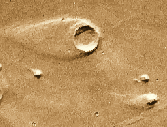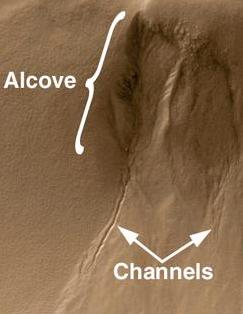 What about in the past?
What about in the past? Apparently, yes. There is evidence from:
Outflow channels and Islands Tear-drop formations, which could only
be explained by heavy flooding water.
Branching runoff channels Looking similar to water carved river
beds and streams.
 How could liquid water have formed?
How could liquid water have formed?
This all suggests a warmer climate with liquid water.
But how? It's not just the cool temperature which is the
problem. It's the low atmospheric pressure!
Early in Earth's history, there was a LOT of CO2 in
the atmosphere from volcanism. Also, numerous impacts kept the
surface much hotter, evaporating a lot of the water/CO2
in the ground. This increases the greenhouse warming. Also, all this
stuff in the atmosphere, will increase the pressure on the ground!
This likely was happening on Mars early on, too, allowing it
to support liquid water on its surface.
The Martian Meteorites
While no NASA mission has brought back rocks from Mars, nature
has brought a few to us! About a dozen meteorites, originating
from Mars have so been identified. These rocks, unlike the
Moon rocks, contain water deposits in them.
Mars Global Surveyor (MGS)
Launched in November, 1996, MGS began mapping Mars in April, 1999 at an
altitude of 250 miles. Perhaps one of the most significant findings
was evidence of water flowing relatively recently.

Gullies seen on Martian cliffs and crater walls in a small number of high-resolution images suggest that liquid water has seeped onto the surface in the geologically recent past.
The gully land-forms are found on slopes facing away from sunlight, and at latitudes from 30° to 70°. The relationship to sunlight and latitude may indicate that ice plays a role in protecting the liquid water from evaporation until enough pressure builds for it to be released down a slope. The relative freshness of these features indicate some of them are active today--liquid water may presently exist at depths of less than 500 meters (1640 feet) beneath the Mars surface.
These results from the MGS have profound implications. A Mars with liquid water might have supported early life on the surface, which may now exist deep below the Martian surface.